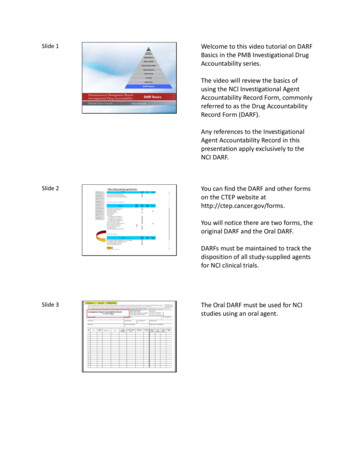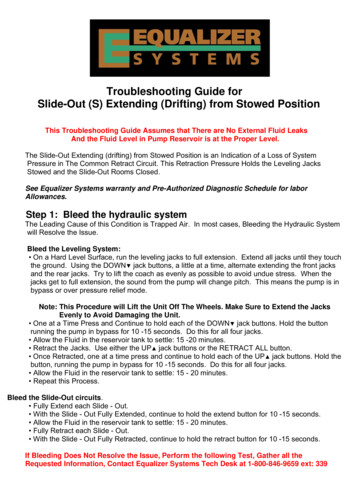
Transcription
Slide 1Welcome to this video tutorial on DARFBasics in the PMB Investigational DrugAccountability series.The video will review the basics ofusing the NCI Investigational AgentAccountability Record Form, commonlyreferred to as the Drug AccountabilityRecord Form (DARF).Any references to the InvestigationalAgent Accountability Record in thispresentation apply exclusively to theNCI DARF.Slide 2http://ctep.cancer.gov/forms/You can find the DARF and other formson the CTEP website athttp://ctep.cancer.gov/forms.You will notice there are two forms, theoriginal DARF and the Oral DARF.DARFs must be maintained to track thedisposition of all study-supplied agentsfor NCI clinical trials.Slide 3The Oral DARF must be used for NCIstudies using an oral agent.
Slide 4The original DARF must be used for allNCI studies using formulations notintended for oral administration.Examples include injectable, topical andimaging agents.Slide 5Now let’s look at the DARF. Notice thatwithin the electronic form availablefrom the CTEP website, the headercontains writable fields. The remainingfields are not writable, but are lockedfor change control and requirehandwritten entry.Writable fieldsHandwrite individual entriesOnce the header fields are completedfor a specific protocol, the form may besaved to generate additionalaccountability pages. The edited formmay be saved to the user’s computer ifproper Adobe software is available.
Slide 6Slide 7Slide 8If the specific protocol DARF is saved orprinted for future use, check theexpiration date in the upper right-handcorner to be sure the document is stillin date prior to use.eDARF Corrections Made on the DARFIf your institution uses drugaccountability software or eDARFs, thedatabase must be able to produce apaper printout that is identical to theNCI DARF. PMB does not endorse anyparticular eDARF pharmacy package.Corrections made to any paper DARFmust be neatly lined out, initialed anddated as in the example on line 14.Erasures or “whiteouts” are notacceptable as shown in the example online 11.Corrections made in any electronicaccountability system also need to beappropriately documented.
Slide 9Separate DARFs are required for eachprotocol and for each orderinginvestigator.Protocol-Specific DARFsProtocolOrderingInvestigatorStrength1Slide 10Agent 1Agent Strength2Strength3Each agent formulation for thatprotocol must have a separate DARF.Additionally, each strength for thatparticular agent requires a separateDARF.Protocol-Specific DARFsProtocolOrderingInvestigatorStrength1Slide 11Agent 1Agent Strength2Strength3In the example, six DARFs are required,one for each strength.Protocol-Specific DARFsProtocolOrderingInvestigatorStrength1Agent 1Agent Strength2Strength3PMB encourages sites to order agentsfor only one investigator per protocol tominimize the total number of DARFsbeing maintained.Control dispensing areas and satellitedispensing areas maintain separateDARFs.
Slide 12Please note that protocol-specificDARFs are not agent lot specific.Multiple lots of the same strengthshould be tracked on the same DARF.DARFs are continuous records that mayspan many pages during the life of aprotocol.Protocol-specific DARFs are used totrack agent disposition for multiplepatients on the same study.Slide 13Patient-Specific DARFsProtocolOrdering InvestigatorPatientAgentFormulationStrength 1Slide 14Strength 2Strength 3Patient-Specific DARFsProtocolOrdering InvestigatorPatientAgentFormulationStrength 1Strength 2Strength 3Protocols that use patient-specificsupplies (e.g. placebo-controlledstudies) are tracked by protocol and bypatient. Patient-specific supplies usethe Julian date and order number asthe lot number.Refer to the protocol document if youare unsure whether agent supplies arepatient-specific.Separate DARFs are required for eachpatient on that protocol. Each agentformulation for that protocol must havea separate DARF. Additionally, eachstrength for that particular agentrequires a separate DARF.
Slide 15Slide 16Slide 17http://ctep.cancer.gov/branches/pmb/agent /clinicalTrials/monitoring.htmPharmaceutical Management Branch, CTEP, NCIEmailPMBAfterHours@mail.nih.govPhone(240) 276-6575NCI YouTubehttps://www.youtube.com/user/NCIgov/To recap, DARFs track the disposition ofinvestigational agents used for NCIclinical trials. To learn more, pleaserefer to the “PharmaceuticalManagement Branch Policy andGuidelines for Accountability andStorage of Investigational Agents”available here on the PMB website.Another helpful resource is Section 5.3(agent accountability and pharmacyoperations) of the “NCI Guidelines forAuditing Clinical Trials for the NCTN”found on the Clinical Trials MonitoringBranch (CTMB) website.Thank you for watching this videotutorial. Additional PMB InvestigationalDrug Accountability videos are availablethrough our YouTube Playlist.Please note that the video and anyitems displayed within the videos aresubject to change. Check backperiodically for updates.Questions can be directed to thePharmaceutical Management Branch,CTEP, NCI by phone Monday throughFriday from 8:30am to 4:30pm EasternTime or by email any time.
Slide 18U.S. Department of Health and Human ServicesNational Institutes of Health National Cancer uced September 2014
clinical trials. To learn more, please refer to the “Pharmaceutical Management Branch Policy and Guidelines for Accountability and Storage of I











